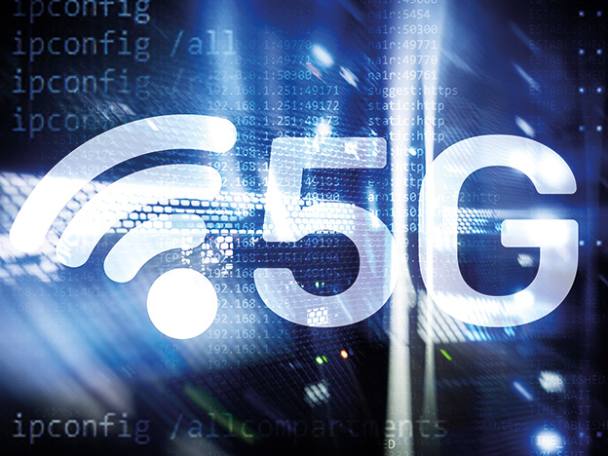“Merry Christmas” - the simple, yet pioneering first ever text message – sent in December 1992. This was the era of second-generation, or ‘2G’ wireless network technology – succeeding the voice-only transmissions of the 1980s, when the cumbersome brick phone was the device du jour.
3G marked the advent of mobile internet, and the birth of the smartphone. Then 4G arrived – launched in this country in 2012. With it came more reliable coverage and download speeds of more than 10 megabytes per second (Mbps) – double those typical of its predecessor.
Suffice to say that mobile telecommunications have evolved dramatically over the past few decades. But the greatest evolutionary, or, rather, revolutionary, step is only taking place now – providing a range of opportunities and implications for companies across myriad industries. Enter 5G.
A “quantum leap”
Ofcom – the UK’s communications regulator – notes that the latest standard is expected to offer peak speeds of 10-20 gigabits per second. It should also drive lower latency – meaning that the time taken between making a command and seeing a response will appear instantaneous. And it’s anticipated that 5G will facilitate higher capacity – allowing more gadgets to be linked up to the internet and each other than ever before.
5G caters to our increasing dependence on data and connectivity. Ofcom found that in 2017 alone the amount of mobile data we used surged by over 40 per cent. The new technology should also help with mobile congestion. No bad thing; a report from Ericsson found that, on average, six in 10 consumers in mega/metro cities have faced issues with 4G connections in crowded places such as shopping streets.
But beyond consumer benefits, 5G has also been tipped as a driver of the ‘internet of things’ – the global web of connected machines – potentially fuelling technological innovation from smart manufacturing to driverless cars. Little wonder, perhaps, that some see it as foundational to the ‘fourth industrial revolution’. Hans Vestberg, chief executive of US telco Verizon (US:VZON), has called it a “quantum leap” compared with 4G.
High expectations
Internationally, 5G activity has been heating up in recent months. We’ve seen multiple commercial launches of 5G services by telecoms operators, led by US and South Korean companies. At the end of May, BT’s (BT) EE mobile business was the first to launch in the UK. Vodafone (VOD) followed suit in July. Their peers Three and O2 plan to join the club in August and October, respectively.
Such commotion has bred significant hype – and with hype has come high expectations about 5G’s ability to meet its mountainous promise. Experience shows us that mobile technologies take time to bed in and unfold. The GSMA – which represents the interests of mobile operators worldwide – notes that 4G only overtook 2G to be the leading mobile technology in 2018. The GSMA expects 4G to surpass half of mobile connections in 2019, reaching 60 per cent in 2023.
Consumers will also need to upgrade to 5G-enabled smartphones. At the end of 2020, Deloitte expects 5G handset sales to represent around 1 per cent of all smartphone sales – with sales “taking off” in 2021. It follows that 5G’s benefits – and challenges – will continue to be realised over time. We’re arguably still in the early stages of gauging the new epoch’s investment opportunities.
How does it work?
To deliver 5G, network operators need access to spectrum at specific frequencies. Ofcom is working to make spectrum accessible at three such frequencies. Low-frequency (700 Megahertz, or MHz) spectrum can help to improve coverage, as lower frequencies travel further. Mid-frequency (3.4-3.8 GHz) spectrum offers higher capacity for mobile broadband over wide areas. High-frequency (26 GHz) spectrum, also known as mmWave, is expected to be used for new 5G applications requiring high capacity and low latency – both by network operators and other organisations. But high frequencies have a shorter range, meaning they can’t travel far, hence the extensive roll-out of supporting masts and related infrastructure.
Ofcom notes that 5G in the longer term will probably see much greater deployment of small cells, or small base stations, which can help to boost capacity in areas with high levels of demand, such as city centres, and which could be mounted anywhere from lamp posts to bus stops.
Spectrum spend
Telecom players bid at auctions around the world to acquire the spectrum they need. BT – a former IC tip of the year – acquired 40MHz of 3.4GHz spectrum suitable for 5G services from Ofcom in April 2018. It expects to bid in another spectrum auction in Spring 2020.
Spectrum impacts telcos’ cash flows – cash flows that, in BT’s case, are also allocated towards its sizeable pension deficit and returning money to shareholders in the form of dividends. Broker Numis – which has a ‘buy’ rating on BT – expects the group’s “spectrum exceptional” costs next year to land at £500m. After this and other exceptionals including pension top-ups, it expects free cash flow of £181m.
BT’s EE business aims to reach 16 cities with the new technology by the end of 2019, having initially launched in six. “In essence, to win in 5G you need network scale... both fixed and mobile,” says John Karidis at Numis. He also stressed that “having fibre backhaul available is exceedingly important”. Backhaul – as described by a February 2019 House of Commons Library briefing paper on 5G – refers to the link connecting mobile base stations to the core internet/phone network, usually provided by full-fibre broadband cables or fixed-radio links. And aside from the aforementioned lamp posts and bus stops, Mr Karidis notes that “there are also the best part of 80,000 street cabinets that BT owns”.
In all, BT (whose first-quarter results are due on Friday 2 August – after this magazine goes to press) seems well-positioned at this phase of the 5G roll-out process. That said, questions around the sustainability of its dividend have taken centre stage this year. In May, it maintained the prior year’s payout for FY2019, and expects to do the same in FY2020. But chairman Jan du Plessis noted at the AGM in July that BT “will also consider reducing the dividend” a “year or two in the future” as one method of funding its fibre-to-the-premises (FTTP) target. Competition in FTTP has been growing, and some analysts’ cash flow forecasts have fallen in response – something we noted in our recent ‘Income Majors’ piece.
Meanwhile, Vodafone did cut its dividend in May 2019, from 15.07¢ to 9¢. Alongside other cited challenges, high-spectrum auction costs had “reduced [the group's] financial headroom”. We learnt in June that Vodafone had spent €1.88bn on spectrum for 5G services at Germany’s auction. JP Morgan expects Vodafone’s spectrum spend to sit at €4bn for FY2020, falling to €1.4bn for FY2021, with free cash flow post-spectrum of €1.5bn and €4.2bn, respectively.
Recent news has been increasingly positive. On 24 July, the group said it had agreed to share 5G active equipment with O2 on joint network sites across the UK – enabling more people to get 5G faster. On 26 July, its shares surged on the news that it is creating Europe’s largest tower company, separating out its tower infrastructure into a new organisation, which could potentially IPO in time.
Testing, testing
There are, of course, other direct and indirect beneficiaries of 5G. Some might argue that, eventually, all sectors will have seen some knock-on effect from the standard.
Telecoms testing group (and IC buy tip) Spirent Communications (SPT) “has the industry’s broadest and most innovative set of 5G test and service assurance solutions”. It noted within its latest annual report that customers range from tier one service providers to major network equipment manufacturers, along with the largest 5G semi-conductor and device manufacturers. Stephen Douglas – who heads up Spirent’s 5G practice – points to the company’s “unique end-to-end visibility”. Its ecosystem of customers “is across that whole landscape, that whole lifecycle”. He likens Spirent to a “neutral partner”.
Mr Douglas notes that cellular mobile networks are built of three components. The radio, plus the core part of the network – which he describes as the “brains” – and the transport networks, comprising the fibre connecting all the physical assets together. Spirent’s ‘Landslide’ product helps the manufacturers designing networks, by providing a replica of the core network. It also gives an idea of the different levels of traffic that networks must manage.
Fun and games
The entertainment industry is also likely to undergo a shift at the hands of 5G. At a Verizon event in January, Jamie Voris – chief technology officer at Walt Disney Studios – said that “5G is going to change a lot about our business, everything from how we connect to our production facilities around the world to how we deliver our movies to cinemas”.
Also in January, Andrew Day – chief executive of Keywords Studios (KEYS), the supplier of technical services to video games companies – referred to clients investing in cloud-based gaming. “This is an exciting development in the games market as a whole, as 5G mobile networks and expanded internet bandwidths allow for the emergence of platforms aiming to become the Netflix of gaming.”
The hardware question
How might technological hardware progress to accommodate new 5G features? Ericsson found that “most consumers believe that smartphones as they are today cannot leverage the capabilities of 5G”. Some reckon we might be wearing augmented-reality glasses by 2025. But, for now, consumers expect the current generation of smartphones to evolve – bringing new features such as 360-degree cameras and hologram projectors.








